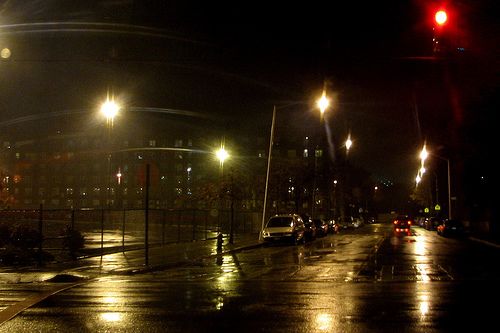Apartment 4 O is the center of life for many of the youth in Park Hill. It's owned by a Liberian woman in her 70's, who sits quietly in her living room observing the young men that use her apartment as a local hangout — smoking, drinking, and sharing stories of life in America. Occasionally, one or two of the men dare to mention Liberia, a home they all share, but hesitate to discuss.
The apartment is always dark and practically empty except for a couch, two mattresses against the wall, some boxes, and a case of beer in the fridge. Two young men — Stanley and James — stare out the barred window at the street below, occasionally calling out to passersby between drags from their cigarettes.
Stanley sits in the corner nursing a beer and talking about his upcoming court date. He has been in Staten Island for seven years and he is still awaiting the resolution of his asylum case. He fears being sent home to Liberia where his mother was brutally murdered for being a member of the Krahn tribe. He thinks the same will happen to him if he returns. Every time he has a court date his lawyer tells the judge she needs more time to prepare the case, Stanley says. Seven years later he is still in limbo, unsure of his status. Now he has a 5-year-old son and as his next court date approaches he worries that if his asylum is denied he’ll have to leave his son to go back to Liberia.
James sits across from Stanley and seems like his alter ego. While Stanley is six feet tall and broad shouldered, James is 5 feet and lanky. Stanley is talkative; James only speaks when he is spoken to. Although James works at a Popeye’s, serving buckets of fried chicken to “white people,” he doesn’t make enough money at the end of the week to rent his own apartment. Instead, he pays an older Liberian man $50 a week to let him sleep on the floor of his apartment. But James has to rely on the man, having no keys of his own to the place, sometimes lingering in the hallways until 4 a.m. until he arrives. At 25, James looks twice his age. The next time I see him, a few days later, he’s drinking beer out of a brown bag in the driver’s seat of a friend’s car.
Suddenly Stanley jumps out of his chair and says that we have to go down to the parking lot. It’s 4 p.m. and I look around me for any clue as to the hastiness of our departure. When we get outside Stanley insists we stand between two cars. I don’t ask too many questions figuring this is just one more of the rules of the street I don’t yet understand. Stanley points out a group of boys on the other side of the lot and says they’re the troublemakers. But just as he says that Isaiah steps out from the huddle of young men and walks toward us.
Twenty-one year old Isaiah has a one-year old daughter, a job, and is finishing up school to get his HVAC license that will allow him to work in heating, air conditioning, and refrigeration. He walks a tightrope trying not to fall in with the wrong crowd, like his older brother Kenje. Although Isaiah and Kenje arrived in Staten Island only months apart, their lives have veered in very different directions. While Isaiah works to take care of his child, Kenje sits in a cell at Rikers Island, awaiting a court date for drug possession. This is Kenje’s third open case in just as many months and the Immigration and Naturalization Service has put a hold on his case preventing him from posting bail until his case is resolved. When Isaiah and Kenje arrived, a cousin, Derrick, had taken them under his wing. But Derrick was a crack dealer, telling the boys about the fast cash and flashy clothes that are part of the life. While Isaiah believed he could make money the slow and steady way, Kenje wanted the fast, easy cash that would give him the freedom he craved.
